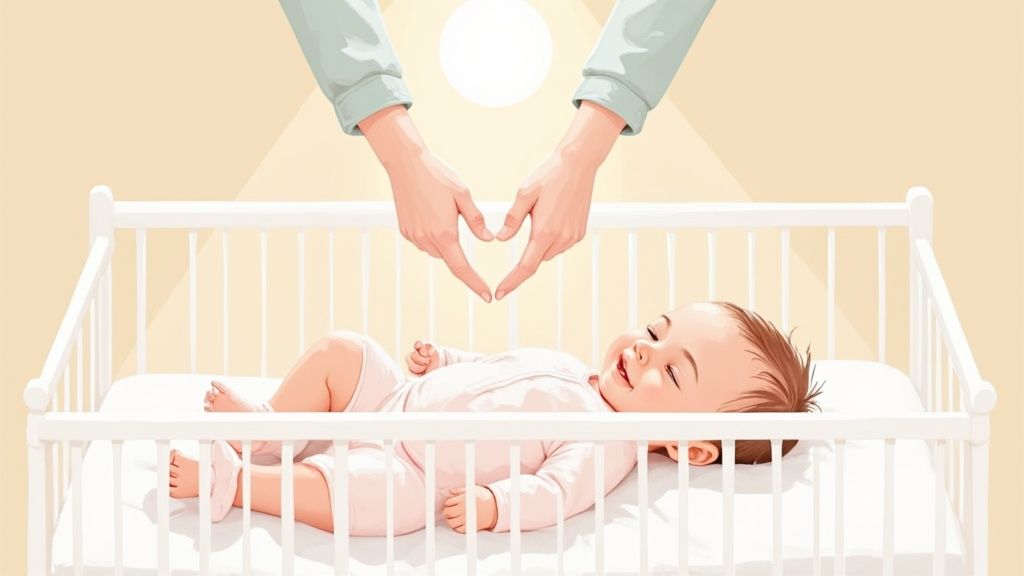
A Parent's Guide to Soft Baby Pajamas
Share
When you're picking out pajamas for your baby, it's easy to get sidetracked by all the adorable patterns. But the truth is, choosing the right soft baby pajamas is about so much more than just looks. It's a decision that genuinely affects your little one's comfort, their delicate skin, and how well they sleep—which, let's be honest, means a better night for you, too.
Why the Right Pajamas Are So Important
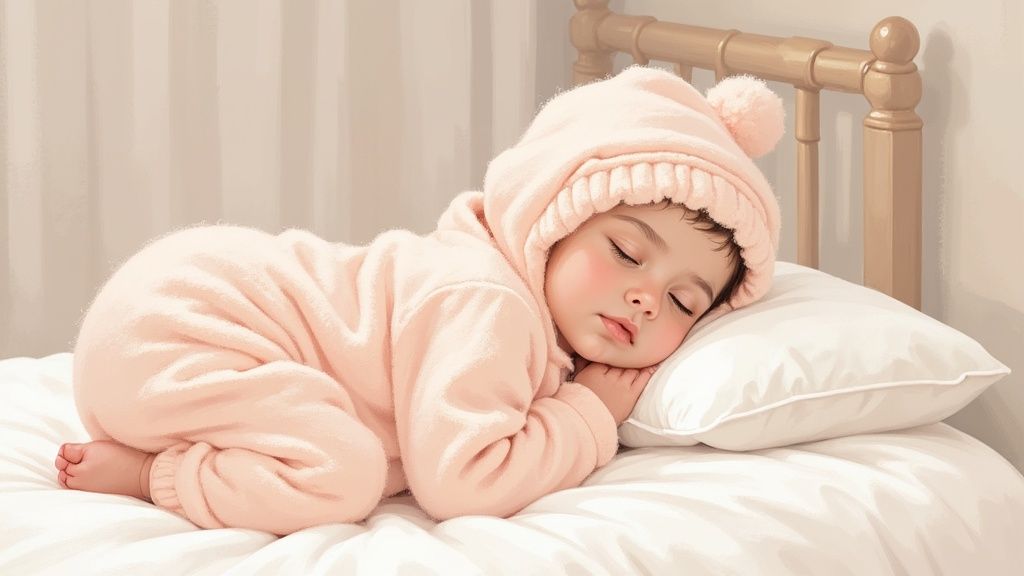
A baby's skin is incredibly delicate and much more porous than ours. This makes them super sensitive to anything rough or irritating. Soft pajamas act like a gentle, protective layer against their skin, almost like a constant, cozy hug that prevents the kind of chafing and discomfort that can wake them up in the middle of the night.
It’s a simple formula, really: a comfortable baby is a happy, well-rested baby. The right PJs become a key part of your bedtime routine, sending a clear signal that it's time to wind down and feel secure.
More Than Just a Cozy Feeling
Beyond just being comfy, the sleepwear you choose is a big part of creating a safe sleep environment. And parents are catching on. This growing awareness has fueled a huge shift in the baby apparel world. The global market for baby sleepwear was valued at a massive USD 42.06 billion in 2023 and is on track to hit USD 61.39 billion by 2030, all because of this focus on safety. You can learn more about baby sleepwear market trends to see just how big this is.
Here’s what well-designed pajamas really do:
- Temperature Regulation: Breathable materials are a must. They help prevent overheating, which is a significant safety risk for infants.
- Safety First: A snug but comfortable fit is crucial. It eliminates the hazards that come with loose, baggy clothing.
- Skin Protection: For babies with eczema or extra-sensitive skin, hypoallergenic fabrics can be a game-changer, helping to prevent irritating flare-ups.
At the end of the day, putting a little extra thought into your baby's pajamas is an investment in more peaceful nights and their overall well-being.
Choosing the Best Fabric for Your Baby
When you’re picking out soft baby pajamas, the fabric is absolutely everything. A baby's skin is so much more delicate and porous than ours, making it super sensitive to anything that isn't incredibly gentle. The material of their PJs is literally the first thing touching their skin all night long.
Think of the right fabric as your baby's personal thermostat. Some materials are amazing at wicking away moisture if you have a sweaty sleeper, while others provide that perfect cozy warmth on chilly nights. Getting to know the differences is the key to picking the perfect pair for your little one.
Comparing Soft Baby Pajama Materials
Let's dive into some of the most common fabrics you'll see on the shelves. Each one has its own special superpowers, and knowing what they are can make your decision a whole lot easier.
| Material | Key Benefit | Best For | Season |
|---|---|---|---|
| Organic Cotton | Hypoallergenic & Durable | Everyday wear & sensitive skin | All Seasons |
| Bamboo Viscose | Buttery Soft & Temp Regulating | Babies with eczema or clammy skin | All Seasons |
| Modal | Silky Smooth & Stretchy | Active babies needing flexibility | Year-round |
| Fleece/Microfleece | Ultra Warm & Insulating | Extra warmth on cold nights | Winter |
Ultimately, the goal is to find that "just right" material that keeps your baby comfortable from bedtime to morning. Whether you need the breathability of bamboo or the classic comfort of cotton, there's a perfect option out there.
A Closer Look at Popular Fabrics
Organic cotton has always been a go-to, and for good reason. It’s tough, it breathes well, and it’s naturally hypoallergenic. It’s basically the comfy, reliable t-shirt of the baby pajama world—it just works.
Then there’s bamboo viscose, which is a total game-changer for many parents. It’s often described as silky, buttery-soft, and incredibly smooth to the touch. It's also a fantastic temperature regulator, helping to keep your baby cool when it's hot and warm when it's not. This amazing breathability makes it a top choice for babies with extra sensitive skin. We cover this in more detail in our guide to the best fabric for sensitive skin.
We're seeing a big shift toward premium, eco-friendly options. More and more parents are looking for clothing that’s free from harsh chemicals and toxins. This has paved the way for sustainable baby sleepwear that’s both unbelievably soft and good for the planet.
As parents have become more aware of what goes into baby clothes, brands have really stepped up their game. The result? Safer, comfier, and more thoughtfully made pajamas for our little ones.
What Parents Are Actually Buying
To give you an idea of what’s popular right now, here’s a quick look at the fabrics parents are reaching for most often.
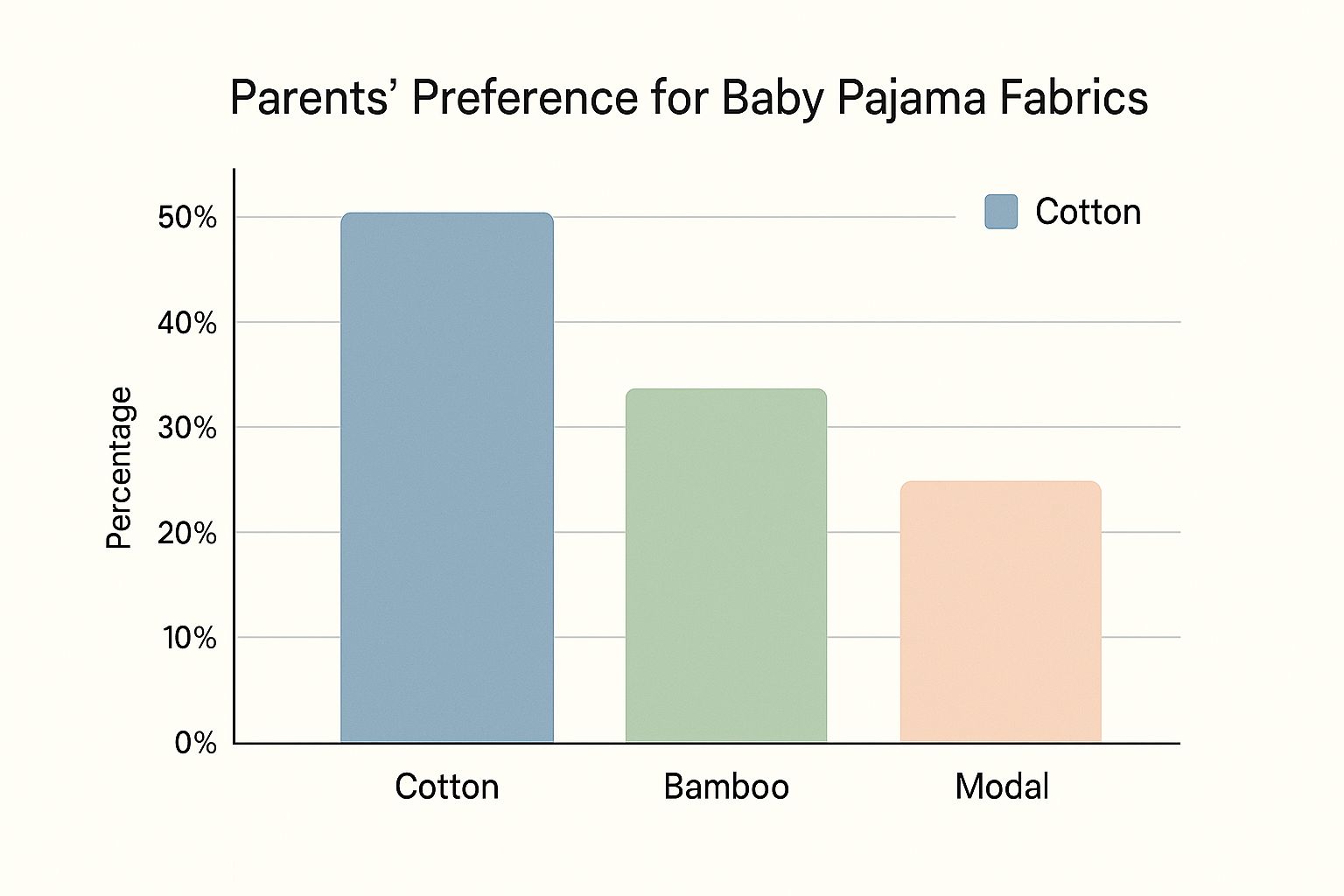
As you can see, classic cotton still holds the top spot at 50%, but alternatives like bamboo (30%) and Modal (20%) are gaining serious ground. It all comes down to matching the fabric to your baby’s specific needs to guarantee a night full of sweet dreams.
Navigating Pajama Safety Standards
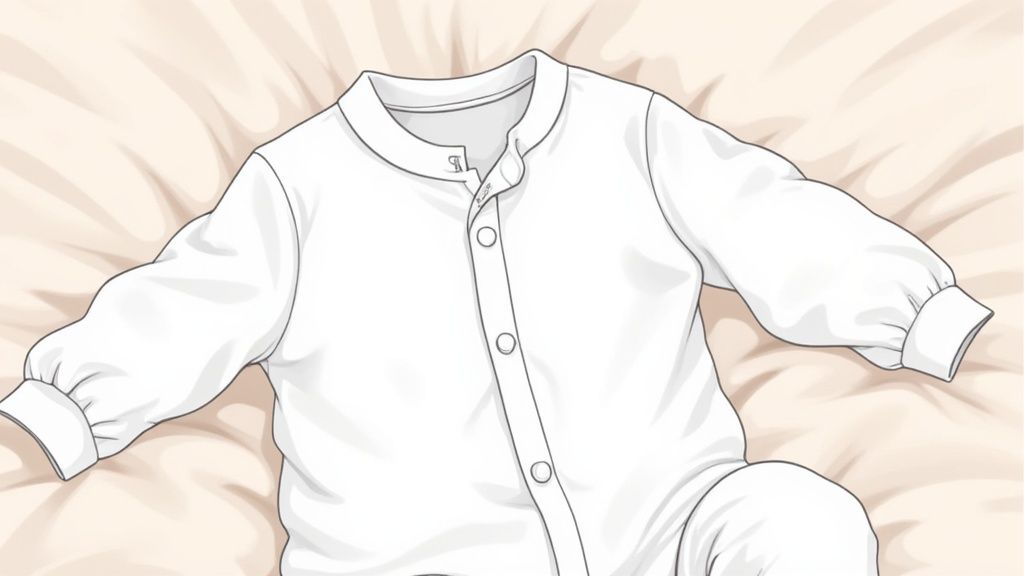
As a parent, your number one job is keeping your little one safe, and that doesn't stop when they're asleep. When it comes to soft baby pajamas, there are some official safety rules in place that can feel a little confusing at first. Don't worry, it really just boils down to two main types: "snug-fit" and "flame-retardant."
Think of snug-fit pajamas as a brilliant, low-tech safety feature. Because they fit so closely to your baby's body, there's very little air between the fabric and their skin. This simple design trick makes the material much less likely to catch fire, so brands can use those wonderfully soft, breathable fabrics like bamboo and organic cotton without needing to add any flame-retardant chemicals.
On the flip side, any sleepwear that's looser—like a nightgown—for babies older than nine months is required by law to be treated with flame retardants. It’s no surprise that most parents just stick with the snug-fitting PJs to avoid those chemicals completely.
Your Simple Pajama Safety Checklist
Beyond the snug-fit vs. flame-retardant choice, a few quick checks can give you total peace of mind. Before you buy a new pair of jammies or get your baby dressed for bed, just run through this mental checklist:
- No Loose Bits: Steer clear of pajamas with long drawstrings, decorative ribbons, or any little add-ons that could become a choking or entanglement hazard. Simple is always safer.
- Solid Hardware: Give any snaps a little tug to make sure they're on tight. If there's a zipper, check for a fabric guard at the top—that little "zipper garage"—to protect your baby's delicate chin.
- The "Just Right" Fit: The pajamas should hug your baby's body without being tight or restrictive. You want them to be able to wiggle and move comfortably, but there shouldn't be any baggy, loose fabric.
You might not realize it, but global safety regulations are the driving force behind how baby pajamas are made. These strict rules are what let parents feel confident when buying sleepwear. In fact, this intense focus on safety is what has pushed brands to develop incredible fabrics that are not only soft but also hypoallergenic and fantastic at regulating temperature. You can dive deeper into these industry trends in this global baby sleepwear market report.
Once you've got these safety basics down, picking out pajamas becomes so much easier. The next piece of the puzzle is just making sure you layer them correctly based on the temperature in the nursery. We've got you covered there, too—check out our guide on how to dress baby for sleep for more tips.
Finding the Perfect Pajama Style and Fit
Picking out the right style of soft baby pajamas might seem like a minor detail, but trust me, it can make a world of difference during those 3 AM wake-up calls. The real goal is to find a design that fits your baby's current stage and makes your life just a little bit easier.
You really can't go wrong with a classic one-piece zippered pajama. They're the absolute champions of convenience, especially the ones with a two-way zipper. Being able to unzip from the bottom for a quick diaper change without completely undressing your baby is a lifesaver when you're trying to keep them warm and drowsy.
As your little one gets bigger, though, other styles start to make more sense. Sleep sacks are amazing for keeping babies snug and safe, acting as a wearable blanket without the risks that come with loose bedding in the crib.
Matching Styles to Milestones
The best pajama style really changes as your baby grows. What's perfect for a tiny newborn isn't going to be the best choice for a busy crawler or a toddler who's starting to potty train.
-
Newborns (0-3 months): One-piece footed pajamas or sleep gowns are your best friend. They keep those little feet toasty and make those constant diaper changes a breeze.
-
Crawlers (6-12 months): Once they're on the move, footless pajamas are fantastic. They give your little explorer the grip they need to pull up and start cruising around without slipping.
-
Toddlers (12+ months): As they get more independent, two-piece pajamas are the way to go. They're great for freedom of movement and make potty training so much simpler.
Style is important, but the right fit is everything. Pajamas need to be snug to be safe—you want to avoid any loose fabric that could become a hazard. But they also need enough room for wiggling and growing. Think of it as a gentle hug, not a tight squeeze. That's the sweet spot for a safe and comfy night's sleep.
How to Keep Pajamas Soft and Long-Lasting
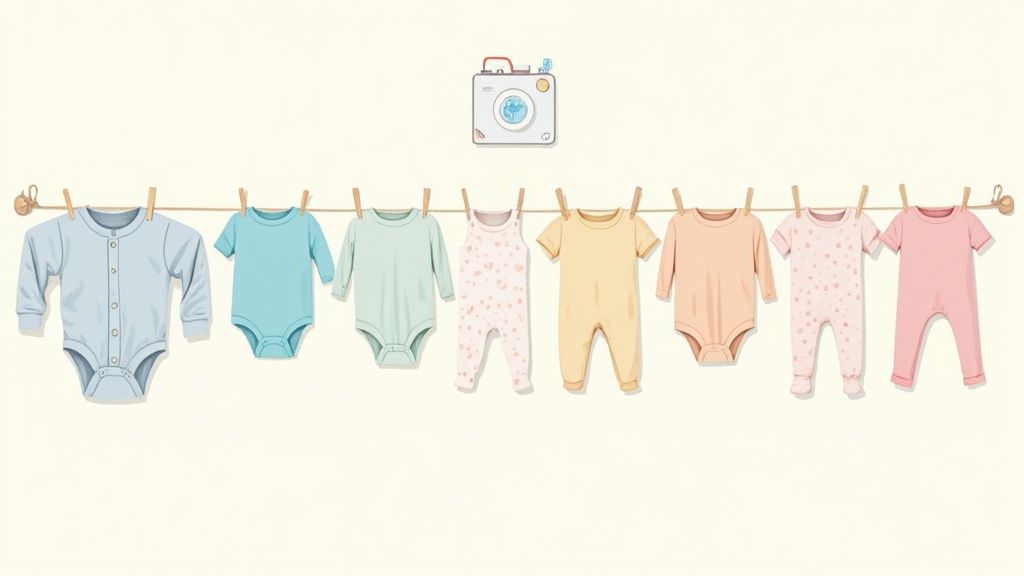
So you've found the perfect, buttery-soft pajamas for your little one. The last thing you want is for them to turn stiff and scratchy after a few washes. Keeping them feeling brand new isn't just about comfort—it’s about making your investment last through all those growth spurts and late-night cuddles.
The secret is simple: treat delicate fabrics like bamboo and organic cotton gently. High heat is the number one enemy of softness; it breaks down the fibers, leading to shrinking and those annoying little pills. Always, always wash on a cold, delicate cycle.
Washing and Drying Best Practices
To lock in that cloud-like feel for the long haul, a few small tweaks to your laundry routine can make all the difference.
- Turn Inside Out: This is such a simple trick, but it works wonders. Washing pajamas inside out protects the soft outer surface from the friction of the wash cycle, keeping colors bright and preventing pilling.
- Use a Gentle Detergent: Stick with a mild, baby-safe detergent. Harsh chemicals aren't just bad for sensitive skin; they're also tough on delicate fibers. For a deeper dive, check out our guide to chemical-free baby products.
- Low Heat is Your Friend: If you must use a dryer, tumble dry on the absolute lowest heat setting. Honestly, the best method is to air-dry them flat. It’s the surest way to keep them looking and feeling exactly like they did on day one.
We all know spit-up and diaper blowouts are part of the deal. For those stubborn stains, just pre-treat the spot with a dab of baby-safe stain remover or a little paste made from detergent and water. Let it sit for about 15 minutes before tossing it in the wash.
Follow these easy steps, and you’ll keep every pair of soft baby pajamas cozy and comfy, ready for another night of sweet dreams.
Answering Your Top Questions About Soft Baby Pajamas
Even after you've done all your research, you might still have a few questions floating around. Let's tackle some of the most common ones parents ask, so you can pick out the perfect PJs with total confidence.
How Many Pairs of Pajamas Does a Baby Actually Need?
It's a classic question! A good rule of thumb is to aim for 5-7 pairs. This gives you a fresh set for every night of the week, with a couple of extras on hand for those inevitable middle-of-the-night blowouts or spit-up surprises.
If you have a newborn, you might want to bump that number up to 8 or 9. They can go through outfits like you wouldn't believe! Having a healthy stash means you won't be chained to the washing machine just to have clean pajamas ready for bedtime.
Is Bamboo Really Better Than Cotton?
This is the big debate, isn't it? The honest answer is that one isn't "better" than the other—it all comes down to what works for you, your baby, and your budget.
Bamboo viscose is famous for its almost silky, buttery-soft feel. It’s also incredibly breathable and wicks moisture away from the skin, which is a lifesaver for sweaty sleepers or babies with sensitive skin conditions like eczema.
On the other hand, organic cotton is a tried-and-true classic. It's durable, naturally hypoallergenic, and often a little easier on the wallet. The best choice is whatever feels right for your family.
At the end of the day, what matters most is choosing a material that's gentle and safe. Look for certifications like Oeko-Tex® Standard 100, which means the fabric has been tested for harmful substances. It’s a simple way to get some extra peace of mind.
What's a TOG Rating, and Why Should I Care?
Don't let the technical name fool you. TOG simply stands for Thermal Overall Grade, and it’s a straightforward way to measure how warm a piece of clothing is. You'll see it on sleep sacks and swaddles all the time, but the concept is helpful for any sleepwear.
Here’s a quick breakdown:
- Low TOG (0.5 - 1.0): Perfect for warm rooms and hot summer nights.
- Medium TOG (1.0 - 2.0): The sweet spot for year-round use in most homes.
- High TOG (2.5+): Designed to keep your baby cozy in colder rooms during winter.
Knowing the TOG rating helps you dress your baby just right for the temperature of their room. It completely removes the guesswork and ensures they stay comfortable—not too hot, not too cold—without the need for loose blankets, which are a known SIDS risk.
Footed vs. Footless Pajamas: Which Is Better?
Ah, the great footie debate! This one really depends on your baby’s age and the time of year. Footed pajamas are fantastic for little babies, keeping their tiny toes toasty warm without you having to hunt for socks that always seem to disappear. They’re the definition of an all-in-one cozy outfit.
But once your little one starts pulling up and getting ready to walk, those footies can get a little slippery. Footless pajamas give their feet the freedom to grip the floor, which helps with balance. Plus, you’ll get more use out of them—they won’t be outgrown the second your baby has a growth spurt in their feet!
Ready to find sleepwear that's as gentle and inspiring as your little one? Explore the gorgeous collection of bamboo pajamas at Little Venture Co. and wrap your baby in the comfort they deserve for the sweetest dreams. Find your new favorites today!
